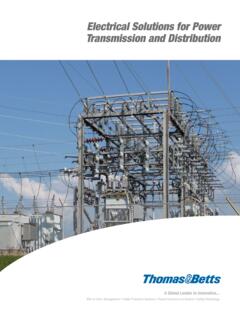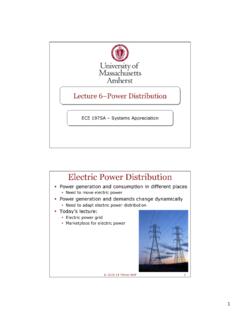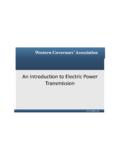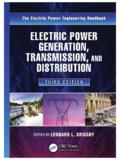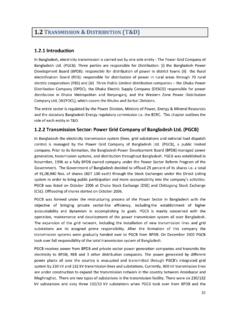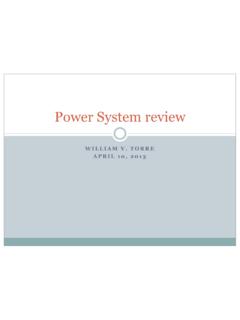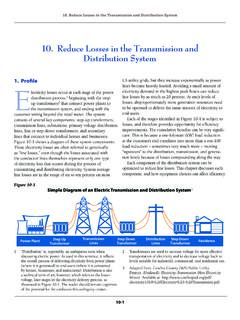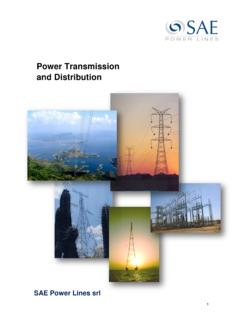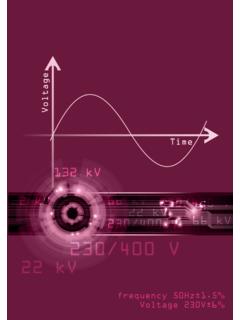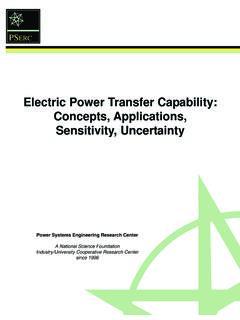Transcription of Design overhead distribution systems - epu.edu.vn
1 Electrical, Electronics Engineering Department Design overhead distribution systems UETTDRDS05B (Vol 1 of 2) Version No 1 2 3 4 5 Date 10/2005 06/2009 05/2010 Refer to: DMcR DK DK Chisholm Institute of TAFE Dandenong Campus Stud Road DANDENONG 3175 Tel: +61 3 9212 5200 Fax: +61 3 9212 5232 Design overhead distribution systems 2 This page intentionally left blank Design overhead distribution systems 3 Contents Electric power transmission .. 5 overhead transmission .. 7 Structures .. 8 Conductors .. 9 Train power .. 10 Further 10 Usage of area under overhead power lines .. 11 Electricity power Supply systems .. 12 distribution systems and Voltage Levels .. 12 Types of distribution feeder systems .. 14 Revision exercise 1 .. 17 overhead and Underground power systems .
2 18 overhead Insulated Conductors .. 19 Revision exercise 2 .. 19 Three Phase, Single Phase and Single Wire Earth Return systems .. 20 Revision Exercise 3 .. 26 Revision Exercise 4 .. 28 Revision exercise 5 .. 31 Terminology .. 33 Revision exercise 6 .. 34 Revision exercise 7 .. 39 Equipment used in the control of voltage .. 40 Types of voltage regulators .. 42 Revision exercise 8 .. 47 Revision exercise 9 .. 51 Wires and Cables .. 53 Design overhead distribution systems 4 MODULE TITLE Design overhead distribution systems Nominal Duration 40 hours Module Code or Number UETTDRDS05A Transmission, distribution and rail power systems Powerline distribution installation High voltage SWER system List of essential resources - Voltage regulation relay - typical working sample - Line drop compensator - Phantom line circuit - simulating a typical transmission or distribution feeder - Sample VT and CT - Local distribution system diagrams - with fault levels indicated - Low voltage AC supply - Extra low voltage AC supply - Low voltage DC supply Items such as the voltage regulation relay, line drop compensator and VT may be difficult to obtain.
3 Student exposure to this equipment may be obtained with the aid of industrial visits. Design overhead distribution systems 5 Electric power transmission Electric power transmission is the bulk transfer of electrical energy, a process in the delivery of electricity to consumers. A power transmission network typically connects power plants to multiple substations near a populated area. The wiring from substations to customers is referred to as electricity distribution , following the historic business model separating the wholesale electricity transmission business from distributors who deliver the electricity to the homes. Electric power transmission allows distant energy sources (such as hydroelectric power plants) to be connected to consumers in population centres, and may allow exploitation of low-grade fuel resources such as coal that would otherwise be too costly to transport to generating facilities.
4 Design overhead distribution systems 6 Transmission lines Usually transmission lines use three phase alternating current (AC). Single phase AC current is sometimes used in a railway electrification system . High-voltage direct current systems are used for long distance transmission, or some undersea cables, or for connecting two different ac networks. Electricity is transmitted at high voltages (110 kV or above) to reduce the energy lost in transmission. power is usually transmitted as alternating current through overhead power lines. Underground power transmission is used only in densely populated areas because of its higher cost of installation and maintenance when compared with overhead wires, and the difficulty of voltage control on long cables.
5 A power transmission network is referred to as a "grid". Multiple redundant lines between points on the network are provided so that power can be routed from any power plant to any load center, through a variety of routes, based on the economics of the transmission path and the cost of power . Much analysis is done by transmission companies to determine the maximum reliable capacity of each line, which, due to system stability considerations, may be less than the physical or thermal limit of the line. Deregulation of electricity companies in many countries has led to renewed interest in reliable economic Design of transmission networks. A power station (also referred to as a generating station, power plant, or powerhouse) is an industrial facility for the generation of electric power .
6 power plant is also used to refer to the engine in ships, aircraft and other large vehicles. Some prefer to use the term energy centre because it more accurately describes what the plants do, which is the conversion of other forms of energy, like chemical energy, gravitational potential energy or heat energy into electrical energy. However, power plant is the most common term in the , while elsewhere power station and power plant are both widely used, power station prevailing in many Commonwealth countries and especially in the United Kingdom. At the center of nearly all power stations is a generator, a rotating machine that converts mechanical energy into electrical energy by creating relative motion between a magnetic field and a conductor.
7 The energy source harnessed to turn the generator varies widely. It depends chiefly on which fuels are easily available and on the types of technology that the power company has access to. Hydroelectric Station Steam Electric StationDESIGN overhead distribution systems 7 overhead transmission overhead conductors are not covered by insulation. The conductor material is nearly always an aluminium alloy, made into several strands and possibly reinforced with steel strands. Copper was sometimes used for overhead transmission but aluminium is lower in weight for equivalent performance, and much lower in cost. overhead conductors are a commodity supplied by several companies worldwide. Improved conductor material and shapes are regularly used to allow increased capacity and modernize transmission circuits.
8 Conductor sizes range from 12 mm (#6 American wire gauge) to 750 mm (1,590,000 circular mils area), with varying resistance and current-carrying capacity. Thicker wires would lead to a relatively small increase in capacity due to the skin effect, that causes most of the current to flow close to the surface of the wire. Today, transmission-level voltages are usually considered to be 110 kV and above. Lower voltages such as 66 kV and 33 kV are usually considered sub-transmission voltages but are occasionally used on long lines with light loads. Voltages less than 33 kV are usually used for distribution . Voltages above 230 kV are considered extra high voltage and require different designs compared to equipment used at lower voltages. Since overhead transmission lines are uninsulated, Design of these lines requires minimum clearances to be observed to maintain safety.
9 Adverse weather conditions of high wind and low temperatures can lead to power outages: wind speeds as low as 23 knots (43 km/h) can permit conductors to encroach operating clearances, resulting in a flashover and loss of supply. Oscillatory motion of the physical line can be termed gallop or flutter depending on the frequency and amplitude of oscillation. An overhead power line is an electric power transmission line suspended by towers or poles. Since most of the insulation is provided by air, overhead power lines are generally the lowest-cost method of transmission for large quantities of electric power . Towers for support of the lines are made of wood (as-grown or laminated), steel (either lattice structures or tubular poles), concrete, aluminum, and occasionally reinforced plastics.
10 The bare wire conductors on the line are generally made of aluminum (either plain or reinforced with steel or sometimes composite materials), though some copper wires are used in medium-voltage distribution and low-voltage connections to customer premises. The invention of the strain insulator was a critical factor in allowing higher voltages to be used. At the end of the 19th century, the limited electrical strength of telegraph-style pin insulators limited the voltage to no more than 69,000 volts. Today overhead lines are routinely operated at voltages exceeding 765,000 volts between conductors, with even higher voltages possible in some cases. overhead power transmission lines are classified in the electrical power industry by the range of voltages: Low voltage less than 1000 volts, used for connection between a residential or small commercial customer and the utility.
